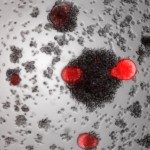Lien vers Pubmed [PMID] – 16869831
Cell. Microbiol. 2006 Nov;8(11):1803-11
When exiting the cell vaccinia virus induces actin polymerization and formation of a characteristic actin tail on the cytosolic face of the plasma membrane, directly beneath the extracellular particle. The actin tail acts to propel the virus away from the cell surface to enhance its cell-to-cell spread. We now demonstrate that African swine fever virus (ASFV), a member of the Asfarviridae family, also stimulates the polymerization of actin at the cell surface. Intracellular ASFV particles project out at the tip of long filopodia-like protrusions, at an average rate of 1.8 microm min(-1). Actin was arranged in long unbranched parallel arrays inside these virus-tipped projections. In contrast to vaccinia, this outward movement did not involve recruitment of Grb2, Nck1 or N-WASP. Actin polymerization was not nucleated by virus particles in transit to the cell periphery, and projections were not produced when the secretory pathway was disrupted by brefeldin A treatment. Our results show that when ASFV particles reach the plasma membrane they induce a localized nucleation of actin, and that this process requires interaction with virus-encoded and/or host proteins at the plasma membrane. We suggest that ASFV represents a valuable new model for studying pathways that regulate the formation of filopodia.

